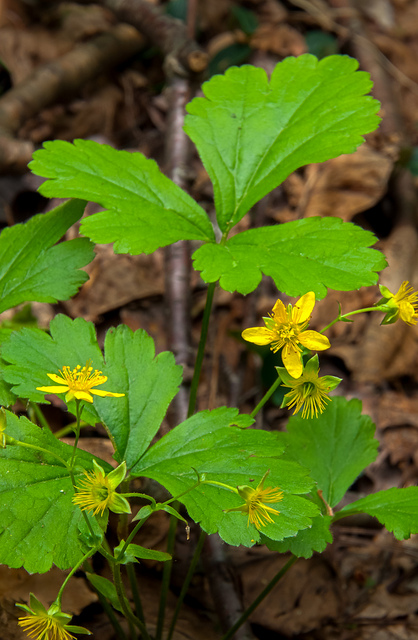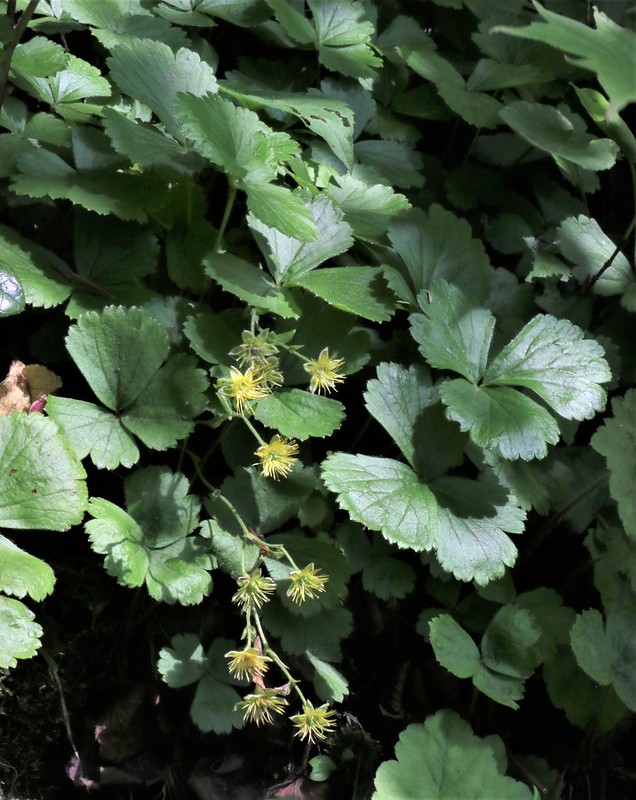Map Snapshot




31 Records
Seasonality Snapshot
Source: Wikipedia
| Barren strawberry | |
|---|---|

| |
| Scientific classification | |
| Kingdom: | Plantae |
| Clade: | Tracheophytes |
| Clade: | Angiosperms |
| Clade: | Eudicots |
| Clade: | Rosids |
| Order: | Rosales |
| Family: | Rosaceae |
| Genus: | Waldsteinia |
| Species: | W. fragarioides
|
| Binomial name | |
| Waldsteinia fragarioides | |
Waldsteinia fragarioides (syn. Dalibarda fragarioides Michx. and Geum fragarioides, [1] also called Appalachian barren strawberry,[2] or just barren strawberry, is a low, spreading plant with showy yellow flowers that appear in early spring. This plant is often used as an underplanting in perennial gardens.
In some ways the appearance is similar to other low plants of the rose family such as Fragaria (strawberries) or Potentilla indica (Indian strawberry), but it lacks runners and has more rounded leaves.[3]
It is native to eastern North America, from Minnesota, Ontario,[4] Quebec, and Maine south to Indiana and Pennsylvania (and as far south as North Carolina in the mountains).[3]
It is evergreen.[5]
Conservation status in the United States
[edit]It is listed endangered in Connecticut,[6] Illinois, and Maine, as threatened in New Hampshire, as a special concern in Massachusetts, and as rare in Indiana.[7]
Native American ethnobotany
[edit]The Iroquois take a compound decoction of the plants as a blood remedy, and apply a poultice of the smashed plants to snakebites.[8]
References
[edit]- ^ "Plants Profile for Waldsteinia fragarioides (Appalachian barren strawberry)". plants.usda.gov. Retrieved 14 May 2018.
- ^ NRCS. "Waldsteinia fragarioides". PLANTS Database. United States Department of Agriculture (USDA). Retrieved 7 August 2015.
- ^ a b Roger Tory Peterson and Margaret McKenny (1968). A Field Guide to Wildflowers of Northeastern and North-central North America. Houghton Mifflin Harcourt. ISBN 978-0-395-91172-3.
- ^ Dickinson, T.; Metsger, D.; Bull, J.; & Dickinson, R. (2004). ROM Field Guide to Wildflowers of Ontario, Royal Ontario Museum, Toronto: McClelland and Stewart Ltd., p.343.
- ^ Richardson, Marc and Dan Jaffe (2018). Native Plants for New England Gardens, p.32.
- ^ "Connecticut's Endangered, Threatened and Special Concern Species 2015". State of Connecticut Department of Energy and Environmental Protection Bureau of Natural Resources. Retrieved 14 May 2018.(Note: This list is newer than the one used by plants.usda.gov and is more up-to-date.)
- ^ "Plants Profile for Waldsteinia fragarioides (Appalachian barren strawberry)". plants.usda.gov. Retrieved 14 May 2018.
- ^ Herrick, James William, 1977, Iroquois Medical Botany, State University of New York, Albany, PhD Thesis, page 352
- Pink, A. (2004). Gardening for the Million. Project Gutenberg Literary Archive Foundation.
External links
[edit]- Waldsteinia fragarioides
- Waldsteinia fragarioides (in French)
 Media related to Waldsteinia fragarioides at Wikimedia Commons
Media related to Waldsteinia fragarioides at Wikimedia Commons

